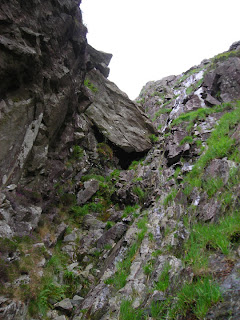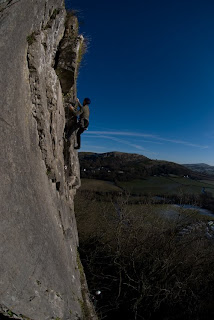
Mike Hamel cruising up the better finishing pitch to Mojo, P2 of Freedom, E2
Access to this amazing crag was banned for twenty years, mainly because climbers behaviour at the crag. In particular climbers cars blocked what until last month was believed to be the landowners drive on the day of a family funeral. As you can imagine Mr Webb was distraught and is far from over his anger at climbers.
With Mr Webb banning access to his land there was little the BMC could do. Then at the end of 2008 another land owner said that no, Mr Webb didn’t own the land and was willing to provide a parking area and access. My guess is that he will be paid a certain amount of cash by the BMC for the parking area, as that is the modern way (We don’t pay for access, just for parking). It is important to remember that the deeds show that Bob Jones owns the land at the top of the crag, the crag and a ten metre strip of land at the bottom. However Mr Jones doesn’t own all of the crag, with another landowner owning the right hand side.
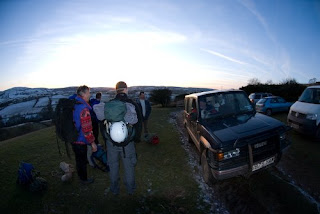
Bob Jones chatting to the assembled climbers
If you visit the crag then look out for Bob Jones he is and extreme friendly and approachable guy. The sort of farmer who when he accosts you, will preceed to chat to you for hours. The day I meet him a Davy Jones pointed out he had his first lamb (It was the 3rd Jan), so after feeding his flock, he collected the new born and came back for another chat.
Despite this new agreement it was not long after the ban was lifted publically by the BMC that reports were coming in locally that Mr Webb had appeared at the crag and was intimidating those climbing, burning bails of hay at the bottom of the crag in an attempt to smoke the climbers off, and generally trying to drive climbers away.
A few locals had been going along and clearing off vegetation, after verbal consultation with the Countryside Council for Wales said that clearing Ivy was acceptable. However this was ammunition for Mr Webb and recently he turned up with the Local Wildlife Enforcement Officer, who whilst unable to intervene for Mr Webb on the civil matter of alleged Trepass, was more interested in the vegetation clearance. As such local climbers were advised to minimise gardening until we can get written permission from the CCW, like we did at tremadog for the gardening days at Craig Blwch Y Moch.
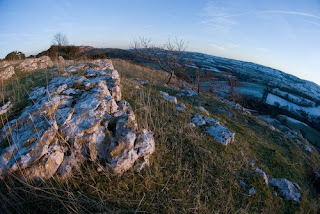
Limestone Pavement at the top of Craig Y Forwen
Now Craig Y Forwen lies within an SSSI, which means it is a protected habitat, fortunately for us it would appear the the status is linked to the limestone pavement at the top of the crag and the bat population at another crag called Craig y Forwen on the map. As such we should be able to gain that written permission, and consultation with the CCW at Craig Blwch Y Moch lead to funding for a woodland management plan through the Better Woods for Wales grants.
However if that permission isn’t granted, and the Environmental Enforcement Officer decides to prosecute, then the land owner Mr Bob Jones and a climber who had his particulars taken down will be the ones in court. I just hope that the BMC sticks by and supports both if it comes down to that, as their cut and run approach to the opening of this crag, left many uncertain of what the situation actually was.
So whilst at present you can access the crag via the new approach described here, and have a PDF guide from the Climbers Club. The chances are that you may well get some hassle from Mr Webb. My advice is to be as courteous as possible and say that Mr Jones has granted us access to his land, and if he would like to contact the BMC over this issue then please do so. Until this issue is sorted out access is still there just be aware that you might have someone shout at you.
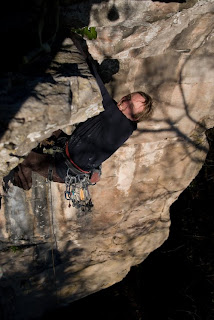
Tony on The Ultra classic Mojo, E1
At a meeting yesterday I heard many arguments over the on going access to this crag, that were many, and included getting planning permission for the creation of a car park. One of the arguments that kept coming up was that climbers have a good relationship with people like the CCW and RSPB, however the rapid clearance of this crag, which although is only ivy has left a obvious mess as to the amount of work that has been carried out, may well damage this.
Whilst the BMC work in gaining access to this crag is great I do wonder why somebody didn’t questioned the land ownership issue earlier. Also after we gained access the BMC have come out with nothing on the on going issue of Mr Webb or further environmental and local issues. Given the status as an SSSI, and the issue of the need to remove ivy, why didn’t the BMC simply wait until written permission was granted before basically setting forth the masses on extreme gardening. Obviously I am using 20/20 hindsight, however there are several other banned crags that the BMC will endeavour to gain access to, when and if they succeed will the BMC have taken on the lessons learnt at Forwen? After all if a site is sensitive enough to be banned, then simply lifting it and disappearing whilst the climbers from all over the UK wade in with dogged enthuisasm seems a little short sighted.
At a meeting of 16 of the Key activist at this crag several Key issues were raise that have not been publicised on the BMC site:
· Keep the noise down – it travels very easily in this valley.
· Go to the toilet before visiting the crag (or bury it at the very least please – the woodland around the crag is used for firewood collection by the land owners)
· Only park at the designated location it was thought that this could cater for up to ten vehicles, the gate has been re-hung and at present the parking site is in good order though this needs monitoring. To reduce the number of vehicles here, consider parking at Castle Inn quarry and sharing cars. It’s probably best not to park at the top of the lane (village green) so as not to antagonise locals. If parking is full go elsewhere (Castle Inn and the 70 Degree’s Crag are under five minutes away!)
· The Crag is loose, proper trad, wear helmets. It is not suitable for large groups of novices or those with little or no trad experience.
· Keep gardening low key; no power tools
· Descent; there are some ab stations and Staircase gully or the left-hand end.
· We agreed it was inappropriate to replace existing bolts because of the noise issue. Fixed gear should be replaced like for like, but, on a route by route basis there may be routes that don’t need fixed gear now. Please use tat in neutral colours.
· There is no access from below the crag.
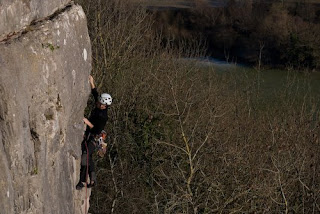
Steve Long on Snotty’s Arete, E3



